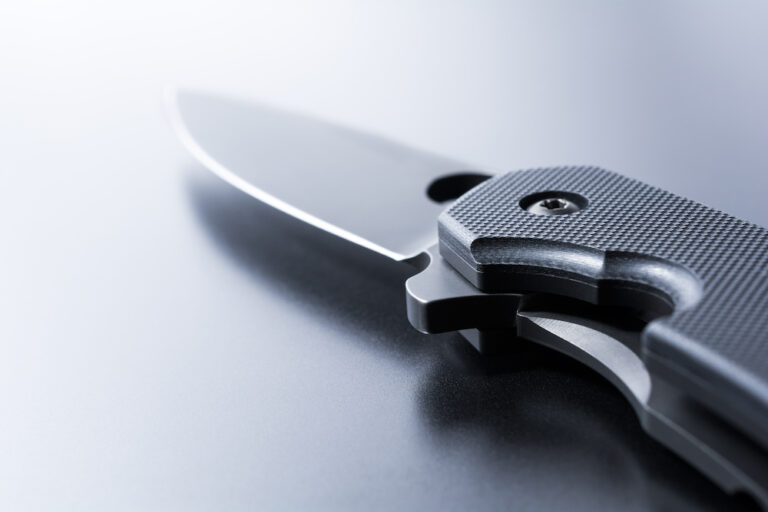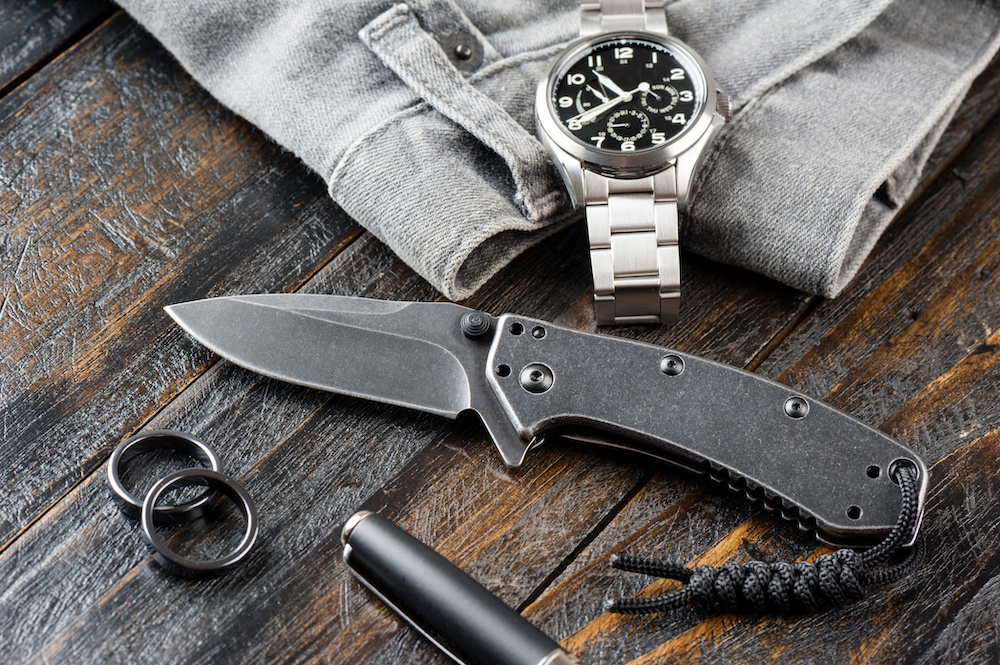Signup for our monthly newsletter and get your FREE "Tactical Gear" Guide
What Makes a Knife Tactical and How to Choose the Best One
- Home
- Tactical Knife Advice
- What Makes a Knife Tactical

This site contains affiliate links to products. We may receive a commission for purchases made through these links.
Are you shopping around for a knife that makes you feel safer, has many uses, or simply looks good?
If so, there is a good chance that you are thinking of getting a tactical knife.
However, before you head to a local or online store, you need to know what makes a knife tactical to ensure you’re purchasing the right tool.
While it is hard to define exactly what a tactical knife is, there are common attributes that can guide your decision-making process.
A good reference point is what Ernest Emerson said: “There are subtle differences between a tactical and a regular knife.“
The key is knowing what to look for, and we have done the heavy lifting for you by outlining what makes a knife blade tactical.
Table of Contents
What Makes a Knife Tactical?
Most knife collectors are familiar with the names Ernest Emerson and Bob Terzuola, as both are prominent custom knife designers.
Some say one of them made the first folding tactical knife, while others say it was the other.
Either way, the tactical knife can trace its roots back to the combat knife used in military service.
As such, it has design elements that make it effective in a fight.
Most knife enthusiasts look for particular attributes like centered weight balance, grippy handle, and handguard.
That said, there are additional features and design variations, depending on who made the knife.
To give you a clearer picture, let’s take a closer look at each of them.
What to Look for When Shopping Around for a Tactical Knife
So you now know that a tactical knife comes from the combat knife.
You also know that it has features you can’t see in regular knives.
Here are additional tips on what to look for when buying a tactical knife:
Fixed Blade vs. Folding Blade
The first thing you need to consider before buying a tactical knife is what type to get.
Tactical knives come in two forms: tactical folders and fixed-blade knives.
Each type has its own advantages and disadvantages.
The S.S. folding knife is easier to conceal and store.
You can just put it in your everyday carry, tactical backpack, or purse.
You can even put it in your pocket for quick access while hunting, camping, or doing any outdoor activity.
Most brands have a reversible pocket clip for this purpose.
However, this design has one key weakness. Much of the force you apply to the folding blade goes to the folding mechanism.
It means that the S.S. folding knife is only as strong as this component.
On the other hand, fixed-blade knives are more durable.
They are more suitable for heavy-duty tasks like skinning or stabbing.
However, fixed-blade knives are harder to store or keep out of plain sight.
Deployment Method
If you go with the S.S. folding knife, you must get one that is easy to deploy.
A mechanism that is hard to operate, or worse, fails, renders the folder useless in an emergency.
The good thing is that many options are available, and you can choose a deployment method that suits you.
Thumb Stud
The thumb stud looks like a lug or a knob integrated into the knife blade.
It is close to the hilt so you can access it quickly using your thumb.
Note that since it is close to the pivot point of the stainless steel blade, it is a bit hard to push.
It takes some getting used to, but it is one of the quickest ways to deploy a steel blade.
Thumb Hole
The thumb hole is similar to the previous method, except it has a hole instead of a stud.
The hole is usually big enough for a thumb pad to fit, distributing the pressure more evenly.
As a result, it makes opening an S.S. folding knife a bit easier.
Finger Flipper
In this mechanism, a piece of metal protrudes at the back of the blade when the knife is closed.
It is called the flipper.
Simply push down on the flipper with your forefinger to open the knife.
Nail Nick
The nail nick is a notch close to the blunt edge of the steel blade.
To open the knife, you need to use one of your fingernails.
It is something that you often see in a pocket knife.

Locking Mechanism for Folding Blades
Aside from blade deployment, another thing that you need to consider when it comes to the folding blade is its locking mechanism.
It prevents the blade knife from closing shut on your fingers while using it.
It is one of the key attributes knife enthusiasts look at because it determines how safe tactical folders are to use.
Many types of knives use other locking mechanisms, but these are among the most common:
Liner Lock or Frame Lock
The liner or frame lock is a piece of metal inside the handle that slides into position when you open the blade knife.
Once it is in place, it blocks the blade from folding back in and injuring your fingers.
Simply push the lock to one side and push the blade back into the handle to close the knife.
Axis Lock or Slide Lock
The axis lock features a spring-loaded bar that slides back and forth inside a slot in the handle.
It moves to one end of the slot as you open the blade and then slides back when fully extended.
The strength of this lock is very high, and the chances of an accident happening is very low.
Lockback
A lockback consists of an exposed piece of metal at the blade spine.
A matching notch close to the hilt hooks onto this piece of metal when the blade knife is fully open.
Note that this mechanism requires to hand to work.
Tri-Ad Lock
A tri-ad lock is a form of lockback that adds a thick stop pin between the back of the tang and the front of the latch.
This design transfers much of the force from the blade and into the handle, preventing it from folding.
Compression Lock
A compression lock is a variation of the liner lock.
It consists of a small metal piece that locks onto a corresponding impression on the blade.
A metal tab at the side releases the lock and allows the knife to fold.
Slip Joint Lock
Using a spring device, the slip joint lock holds the blade in the open position.
This lock releases the blade only if you apply enough pressure to the spring.
Knife Size
Another way to differentiate the type of knife you want to get is by its size.
This decision would depend on where you plan to use it.
Small Knives for Urban Use
If you live in a place where carrying a blade openly is not allowed, you need a small urban knife.
A good rule of thumb is that it has a four-inch blade at the most.
Anything bigger, and you risk losing it to confiscation by law enforcement.
Also, it would help if you get a modern folder that is easy to conceal.
Big Knives for Urban Use
If you want a bigger knife for urban use, your options are a bit limited.
That said, some sizeable models fold into a five-inch handle.
They deploy quickly and cut well but still fit in the pocket.
Small Knives for Rural Use
The countryside does not present much challenge when it comes to concealing.
However, there are potential issues that exist only in this setting.
For instance, you would want your knife to be substantial enough to withstand hacking wood or getting caught on a barbed wire.
Big Knives for Rural Use
If you want something that could hack through wood or fend off wild animals, you would need a big knife.
It is something that you could hide easily, but there are other ways to make it inconspicuous.
One is by having a matte-coated blade that does not draw attention.
Handle Design
Another essential feature of a good tactical knife is an ergonomic handle design.
Many brands shy away from indentations and finger grooves that feel uncomfortable in the hand.
You will often see a straight or slightly contoured handle with just enough texture to maximize grip.
When it comes to tactical knives, the simpler it is, the better.
You are good to go as long as you have a non-slip handle.
It is not good to have handles with intricate designs where dust and dirt can accumulate and affect your grip.
In addition, a very intricate handle is harder to clean and keep clean.
You will only end up wasting a lot of time on its upkeep.
Handle Material
Aside from its design, it is important to look at what material is used to make the handle.
Note that, aside from providing a good grip, the knife handle also absorbs some of the forces from repeated impact.
It must be able to withstand rough handling, especially since you will be using it in high-stress situations.
Many of today’s top brands use the Micarta or G10 handle, which are composites of resin.
Others use wood or metal, with the occasional leather grip.
When looking at a knife handle, make sure that it does not become slippery when it gets wet or damp.
Blade Design
If you have looked at some tactical knives online or in-store, you probably know that there are several designs to choose from.
Here’s a closer look at some of the most popular options:
Tanto Blade
The tanto blade looks like a Japanese katana. Its tip angles off and meets the spine at a point.
The sharp edge close to the tip also angles away, creating a “mini edge.”
It is great for piercing tough materials, making it a favorite among law enforcement personnel and military personnel.
Drop Point Blade
The spine of the drop point blade “drops” and meets the blade edge at a point.
It is designed to optimize balance and comfort during use.
Clip Point Blade Shape
A clip point blade is just like a standard blade except that the top portion appears to be clipped off.
It has a smaller surface area at the tip, making it a great tool for puncturing.
Blade Edge Type
Aside from the blade design, you also need to consider the blade edge type.
There are two options available: the plain edge and the combo edge.
In the combo edge, part of the blade has a serrated edge.
The plain edge does not have any serrations.
Blade Material
The blade material has a significant impact on the quality of a tactical knife.
It determines edge retention, corrosion resistance, ease and method of sharpening, and blade strength.
Many of today’s top brands use stainless steels, “hard” high-carbon steels, or high-vanadium steels.
There are even some that do not use metal at all. Instead, they use plastic mixes that are lightweight and impervious to corrosion.
Stainless steel is the most common, as it is tough and durable.
High-carbon steels are tougher, but they are less flexible.
High-vanadium steel is also tough and durable, but it is harder to sharpen when it becomes dull.
Blade Coating
One of the most distinct characteristics of tactical knives is that they do not draw much attention.
The blade needs to have a black or gray matte finish, so it does not reflect light.
It helps maintain the element of surprise during combat or high-stress situations.
It will also help if the blade has an anodized coating or anti-friction coating to retain its sharp edge longer.
What Makes a Knife Tactical: The Verdict
Whether a tactical knife looks simple or elegant, a lot of thought goes into making it.
It stands to reason that you also have a lot to consider if you want to buy one.
The good thing is that there are ways to simplify your decision-making process.
Simply follow the tips above, and you will have no problem finding a knife to add to your everyday carry or tactical backpack.
